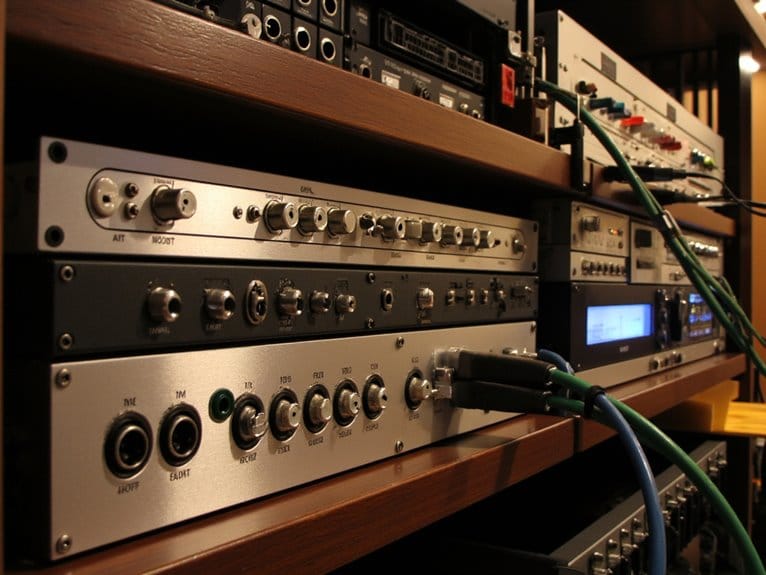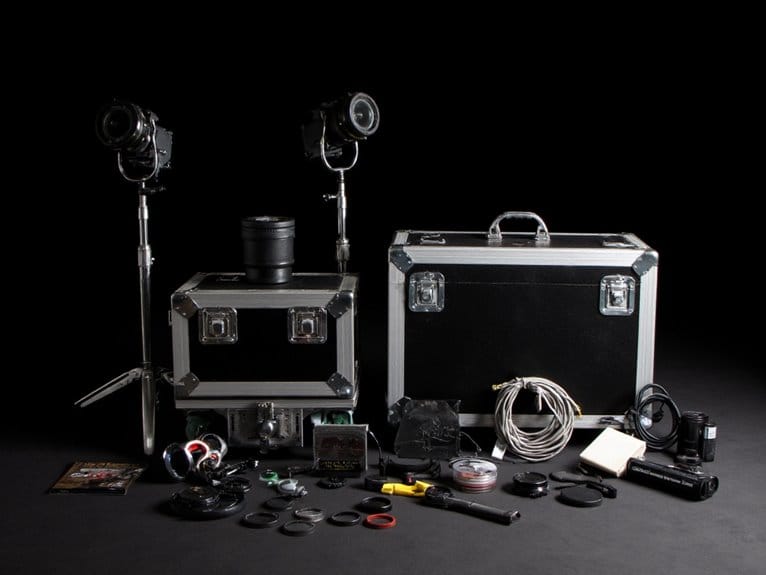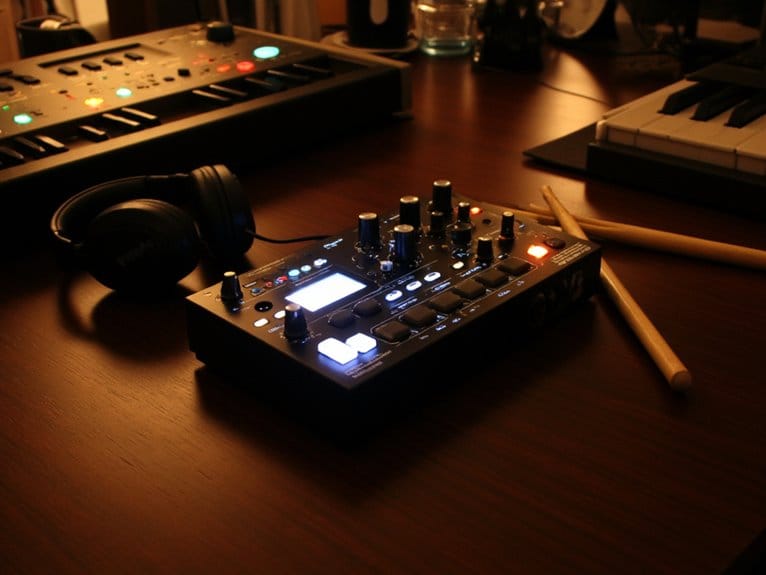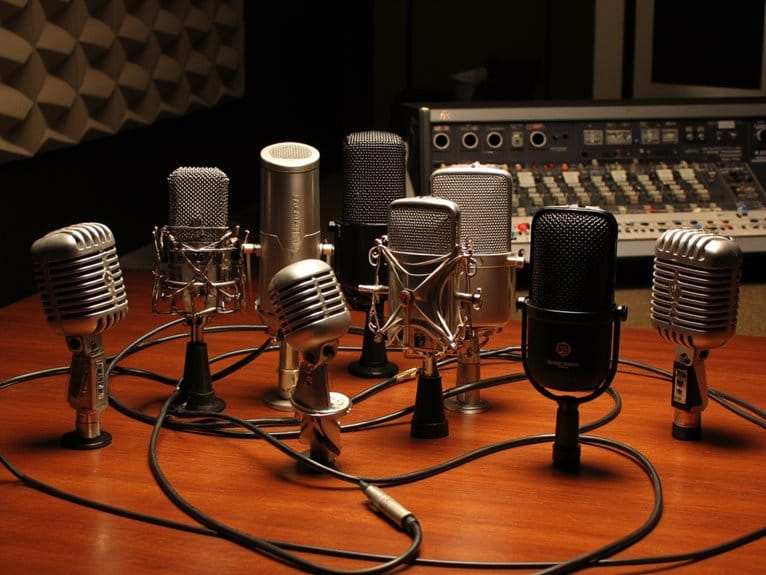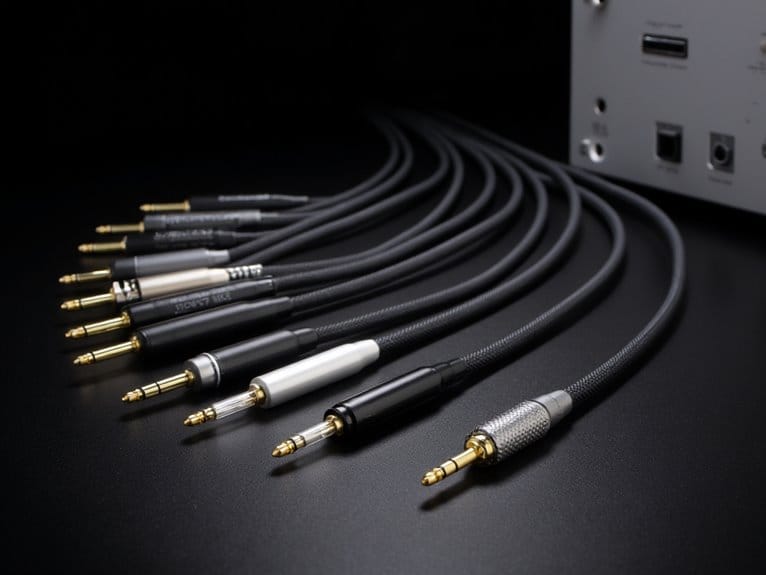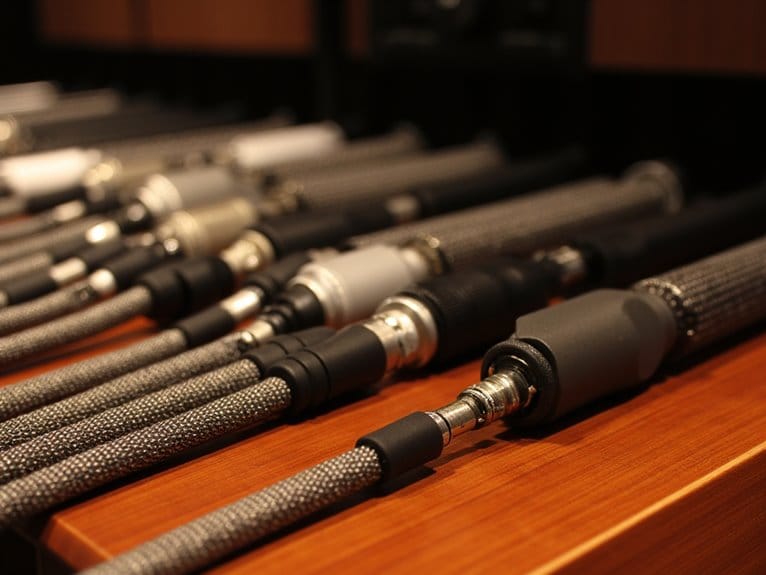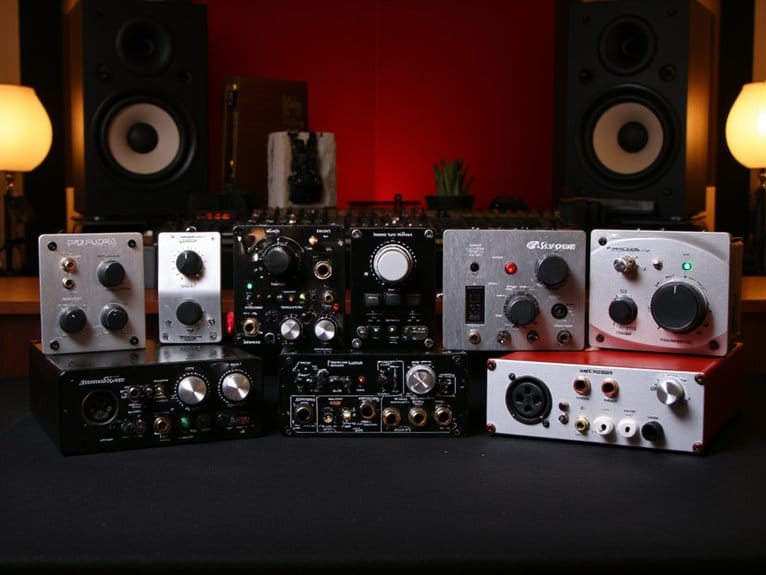10 Best Patch Bays for Professional Audio Recording and Live Sound
Through countless studio sessions, I’ve found the Black Lion Audio PBR XLR Patchbay leads my recommendations with its 32 gold-plated XLR connectors and audiophile-grade construction, while the Art Pro Audio P48 offers exceptional value with 48 balanced TRS points in 1U. For network applications, Cable Matters’ 24-port Cat6 panel supports 10-Gigabit Ethernet, and the versatile 2U blank panels accommodate custom keystone configurations perfectly. Each option below addresses specific routing needs and budget considerations.
We are supported by our audience. When you purchase through links on our site, we may earn an affiliate commission, at no extra cost for you. Learn more.
Notable Insights
- XLR patchbays like Black Lion Audio PBR offer 32 audiophile-grade connectors with gold-plated contacts for professional studios.
- Balanced TRS patchbays provide versatile signal routing with Normal, Half Normal, and Thru modes for flexible audio workflows.
- Consider rack space requirements carefully – 1U units save space while 2U panels accommodate more connections.
- Build quality matters significantly – choose aluminum or steel construction over plastic for durability in demanding environments.
- Integrated cable management features like snap-in rings and adjustable clamps prevent cable chaos and reduce strain.
2U 48 Ports Blank Patch Panel with Cable Manager Bar

For professional audio engineers and studio technicians who demand reliable cable management without the premium price tag of pre-loaded panels, the 2U 48 Ports Blank Patch Panel with Cable Manager Bar represents a smart foundation choice that I’ve found consistently delivers on both flexibility and long-term durability. You’ll appreciate the high-strength thickened steel construction, which handles heavy daily use without warping or loosening connections. The integrated cable management bar, combined with snap-in rings, effectively reduces strain while keeping your rack space organized. Though you’ll need to source your own keystone modules, this blank panel’s removable front labels and UL certification make it a solid investment for custom audio routing configurations.
Best For: Professional audio engineers and studio technicians who need a flexible, customizable patch panel solution and prefer to select their own keystone modules rather than purchasing pre-loaded panels.
Pros:
- High-strength thickened steel construction provides exceptional durability for heavy daily use without warping or connection issues
- Integrated cable management bar with snap-in rings effectively reduces cable strain and maintains organized rack space
- UL, CE, FCC, and ROHS certifications with removable front labels ensure professional-grade reliability and easy customization
Cons:
- Requires separate purchase of keystone modules or adapters, adding to total system cost
- Blank panel design means additional setup time compared to pre-loaded alternatives
- Limited to 48 ports in a 2U form factor, which may not suit larger installations
Black Lion Audio PBR XLR Patchbay

Studio engineers and audio professionals seeking reliable signal routing will find the Black Lion Audio PBR XLR Patchbay delivers the connectivity they need, though I’ll admit the 32 audiophile-grade gold-plated XLR connectors packed into this 1U rack unit caught my attention immediately. You’ll appreciate the four front-panel male XLR connectors that simplify hardware patching, eliminating the need to crawl behind racks during sessions. The black-anodized aluminum construction feels substantial despite weighing just one pound, and the included front panel labels help maintain organization in complex setups. While some users report noise floor issues, the 4.2-star rating suggests most professionals find it reliable for studio work.
Best For: Studio engineers and audio professionals who need reliable XLR signal routing in a compact 1U rack format with easy front-panel access for hardware patching.
Pros:
- 32 audiophile-grade gold-plated XLR connectors provide extensive connectivity options in a single rack unit
- Four front-panel male XLR connectors enable easy patching without accessing the rear of equipment racks
- Durable black-anodized aluminum construction with included front panel labels for organized studio setups
Cons:
- Some units arrive damaged during shipping according to customer feedback
- Reports of noise floor issues affecting audio quality during use
- Limited to 30V maximum voltage which may restrict compatibility with certain high-voltage equipment
Art Pro Audio TPatch – Eight Point Balanced Patch Bay
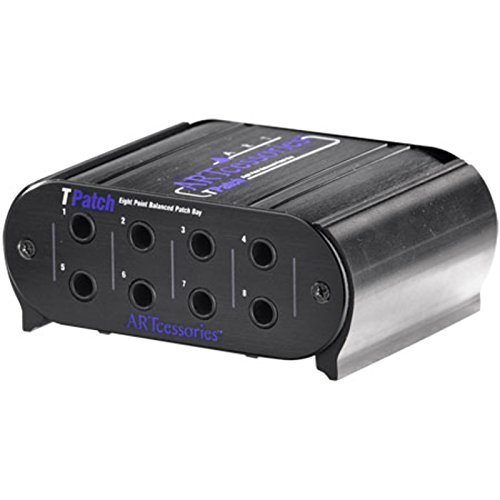
When you’re dealing with limited desktop space but need maximum routing flexibility, the Art Pro Audio TPatch delivers eight balanced connection points in a surprisingly compact package that measures just 3.9 x 4.61 x 1.85 inches. The 1/4-inch TRS jacks support both normal and half-normal operation modes, giving you complete control over signal routing while protecting your expensive gear from excessive wear. Weighing only 14.4 ounces, this passive patchbay’s black-anodized aluminum construction guarantees durability without adding unnecessary bulk to your workflow. Users consistently praise its effectiveness in limited spaces, though some note build quality concerns for specific applications like speaker-level signals.
Best For: Studio engineers and musicians working in compact spaces who need flexible signal routing and want to protect expensive gear from input/output wear while maintaining balanced audio connections.
Pros:
- Compact design maximizes routing flexibility in limited desktop space at just 3.9 x 4.61 x 1.85 inches
- Switchable normal and half-normal operation modes provide complete control over signal routing
- Durable black-anodized aluminum construction with passive design ensures longevity without adding bulk
Cons:
- Build quality concerns reported for specific applications like speaker-level signals
- Limited to 8 connection points which may not be sufficient for larger studio setups
- Some users report functionality issues with straight-through patching applications
Patch Panel 12 Port with Cat6 Keystone Jack Unshielded (1U 12Port)
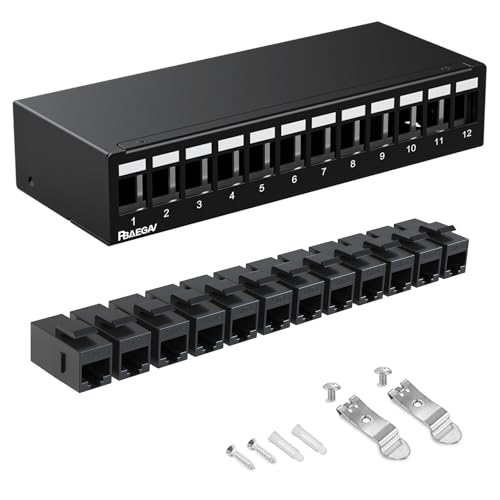
The PBAGEAV Patch Panel 12 Port with Cat6 Keystone Jack Unshielded stands out as an ideal solution for audio engineers and recording professionals who need reliable network connectivity in compact studio environments, offering twelve high-quality ports within a space-efficient 1U rack design. While I’ll admit this isn’t your typical audio patch bay, it’s become indispensable for modern studios requiring robust network infrastructure. The sturdy metal construction features powder coating and thoughtful cable management with adjustable clamps, making installations straightforward even for those who aren’t networking experts. At 4.6 stars from users, it delivers exceptional value considering included keystones would cost considerably more separately.
Best For: Small to medium-sized businesses, home networks, and recording studios that need reliable 12-port network connectivity in a compact 1U rack space with included Cat6 keystone jacks for cost-effective installation.
Pros:
- Exceptional value with 12 Cat6 keystone jacks included, saving significant cost compared to purchasing components separately
- Space-efficient 1U rack design with sturdy metal construction and powder coating finish for durability
- User-friendly features including labeled ports, adjustable cable clamps, and internal cable ties for easy installation and management
Cons:
- Plastic clips have been reported to break easily, potentially causing reliability issues in demanding environments
- Accessing tightly fitted cables can be challenging once installed
- Top cover lacks a handle, making removal more difficult than it could be
ART Pro Audio P48-48 Point Balanced Patch Bay

Professional audio engineers who demand reliable signal routing without breaking the budget will find the ART Pro Audio P48-48 Point Balanced Patch Bay delivers exactly what they need in a compact, no-nonsense package. This 1U rackmount unit features 48 TRS quarter-inch balanced connections, configurable for normal or half-normal operation depending on your routing requirements. The sturdy all-metal chassis weighs just 4.24 pounds while providing reversible rack ears for flexible installation in professional studios, live sound rigs, or home recording setups. With 4.4-star customer ratings and proven durability since 2011, you’re getting reliable performance that handles everything from simple signal routing to complex studio patching without the premium price tag most patch bays command.
Best For: Professional audio engineers and recording studios looking for a reliable, budget-friendly patch bay solution with 48 balanced connections for signal routing in studio, live sound, or home recording environments.
Pros:
- Sturdy all-metal construction with reversible rack ears provides durability and flexible installation options in a compact 1U form factor
- 48 TRS balanced connections with configurable normal/half-normal operation offers comprehensive routing capabilities for professional applications
- Excellent value proposition with 4.4-star customer ratings and proven reliability since 2011 at a competitive price point
Cons:
- Some users report concerns about crosstalk between channels affecting signal quality
- Normalization settings can be difficult to access, making configuration changes challenging during setup
- Limited to TRS quarter-inch connections only, which may not accommodate all studio connector requirements
Behringer Ultrapatch Pro PX3000 48-point 1/4 inch TRS Balanced Patchbay

Behringer’s Ultrapatch Pro PX3000 serves as a studio workhorse that I’ve found particularly valuable for engineers managing complex recording setups, offering 48 points of balanced TRS connectivity in a compact 1U rack design that eliminates the cable spaghetti plaguing many professional environments. You’ll appreciate its three selectable modes per channel-Normal, Thru, and Half Normal-which provide flexible routing options for different studio configurations. While it doesn’t match the build quality of premium brands, the PX3000’s solid performance, smooth jack operation, and cost-effective pricing make it an excellent choice for budget-conscious studios requiring reliable signal management without breaking the bank.
Best For: Budget-conscious recording engineers and studio owners who need reliable 48-point balanced TRS connectivity to organize complex audio setups without the premium cost of high-end patchbays.
Pros:
- Three selectable modes per channel (Normal, Thru, Half Normal) provide flexible routing options for various studio configurations
- Compact 1U rack design with 48 balanced TRS points eliminates cable clutter and improves studio organization
- Cost-effective pricing with solid performance and smooth jack operation makes it accessible for budget-conscious setups
Cons:
- Build quality doesn’t match premium brands, potentially affecting long-term durability in heavy-use environments
- Limited to 1/4 inch TRS connections, which may not accommodate studios requiring XLR or other connector types
- At 4.63 pounds, it’s relatively heavy for a 1U unit, which could be a consideration for portable or mobile setups
ART P16 XLR Balanced Patchbay

ART’s P16 XLR Balanced Patchbay serves as a routing powerhouse for studios and live venues that demand professional-grade XLR connectivity, housing 32 XLR connectors in a single 1U rack space that transforms cable management from chaos into organized efficiency. You’ll appreciate the rugged steel construction and gold-plated connections that maintain signal integrity without degradation, while the normalled wiring configuration allows flexible routing between your mic preamps and outboard gear. The phantom power pass-through capability guarantees your condenser mics stay powered throughout signal chains, and the tight-fitting jacks prevent loose connections during frequent changes that’d drive you crazy during sessions.
Best For: Professional studios, live sound engineers, and broadcast facilities that need reliable XLR signal routing and cable management for mic preamps and outboard gear.
Pros:
- Rugged all-steel construction with gold-plated connections ensures excellent signal integrity and long-term durability
- Phantom power pass-through capability maintains condenser mic power throughout the signal chain
- Normalled wiring configuration allows flexible routing options without signal loss
Cons:
- Higher price point compared to TRS patchbay alternatives may strain smaller budgets
- 1U rack depth requires consideration for installation in shallow rack configurations
- Limited to 16 channels which may be insufficient for larger studio setups
Black Lion Audio PBR XLR Patchbay

When you’re dealing with high-end studio gear that demands pristine signal integrity, the Black Lion Audio PBR XLR Patchbay emerges as the ideal solution for engineers and producers who refuse to compromise on audio quality. This 32-connector powerhouse features audiophile-grade gold-plated XLR connections housed in a sleek black-anodized aluminum chassis, measuring 20.95 x 8.55 x 3.6 inches and weighing just one pound. The front panel’s four male XLR connectors enable quick hardware patching, while the included labeling system keeps your routing organized during those late-night sessions when everything starts looking the same.
Best For: Professional audio engineers and studio producers who need high-quality XLR signal routing and refuse to compromise on audio integrity in their recording setups.
Pros:
- Features 32 audiophile-grade gold-plated XLR connectors for pristine signal integrity
- Compact and lightweight design (1 pound) with durable black-anodized aluminum construction
- Front panel male XLR connectors and included labeling system enable quick and organized hardware patching
Cons:
- Some units may arrive damaged during shipping
- Reports of noise floor issues during use that can affect audio quality
- Limited to 30V maximum which may restrict compatibility with certain high-voltage studio equipment
XLRM3 to XLRF3 Panel Mount Assembly Cable for Patch Bay

Professional audio engineers who demand reliable signal routing solutions will find the XLRM3 to XLRF3 Panel Mount Assembly Cable particularly valuable for its 19-inch rack-mountable design, which integrates seamlessly into existing studio infrastructure while providing eight dedicated connection points. I’ve found that the 19 long shielded cables offer excellent protection against electromagnetic interference, though you’ll need to manage cable routing carefully to avoid tangles. The combination of female XLR panel mounts and male cable terminations creates a versatile setup that’s built for frequent patching, making this assembly ideal for studios where you’re constantly reconfiguring signal paths.
Best For: Professional audio engineers and studio operators who need a reliable, rack-mountable patch bay solution for frequent signal routing and reconfiguration in studio environments.
Pros:
- 19-inch rack-mountable design integrates seamlessly into existing studio infrastructure
- Long shielded cables provide excellent protection against electromagnetic interference
- Built for frequent use with durable construction designed to withstand constant patching
Cons:
- Cable management can be challenging due to 19 long cables that may tangle without careful routing
- Limited to 8 connection points which may not be sufficient for larger studio setups
- Fixed cable length may not be optimal for all rack configurations and distances
Cable Matters 24 Port Cat6 Network Patch Panel (1U Rackmount)

Network administrators and IT professionals who demand reliable, high-speed connectivity will find the Cable Matters 24-Port Cat6 Network Patch Panel delivers exceptional value in a compact 1U rackmount design. Supporting 10-Gigabit Ethernet, POE+, and POE++ standards, this UL-listed panel accommodates Cat6, Cat5e, and Cat5 cabling with gold-plated contacts that guarantee stable connections. The numbered ports and color-coded T568A/T568B wiring diagrams simplify installation, while included D-rings and cable ties maintain organization. Though some users note the absence of port caps, the 4.7-star rating from 1,470 reviews reflects strong satisfaction with its straightforward setup and reliable performance in professional networking environments.
Best For: Network administrators and IT professionals who need a reliable, high-speed patch panel solution for organizing Cat6, Cat5e, and Cat5 cabling in professional networking environments with support for 10-Gigabit Ethernet and POE standards.
Pros:
- Supports high-speed 10-Gigabit Ethernet, POE, POE+, and POE++ standards with gold-plated contacts for stable connections
- Simple installation with numbered ports, color-coded T568A/T568B wiring diagrams, and included cable management accessories
- UL-listed safety compliance and compact 1U rackmount design that fits universal racks, cabinets, or wall-mount brackets
Cons:
- Does not include port caps to keep cables secure during patch panel removal
- Limited to 24 ports which may not be sufficient for larger network installations
- Some users may find the 1-pound weight insufficient for heavy-duty commercial applications
Factors to Consider When Choosing a Patch Bay
When I’m selecting a patch bay for my studio setup, I’ve learned that five critical factors can make or break the effectiveness of my signal routing system, and honestly, I wish someone had explained these fundamentals before I made my first costly mistake. The connector type compatibility determines whether your existing cables will work seamlessly, while rack space requirements affect how efficiently you can organize your gear within limited studio real estate. I’ll examine how build quality materials impact long-term reliability, signal routing options influence creative workflow possibilities, and cable management features determine whether your studio looks professional or resembles a tangled mess of wires.
Connector Type Compatibility
While selecting a patch bay might seem straightforward, I’ve learned that connector type compatibility can make or break your entire studio setup, and honestly, I’ve made this mistake more times than I’d care to admit. Your patch bay must match your equipment’s connectors, whether that’s XLR, TRS, or specialized network connections like RJ45 for digital audio systems. I always verify that standard 1/4-inch TRS or XLR connections align with my audio interfaces, ensuring seamless integration without adapters that degrade signal quality. Pay attention to pin configurations too-three-pin XLR connectors handle phantom power differently than their five-pin counterparts, affecting microphone performance. For hybrid setups incorporating network audio, RJ45 compatibility becomes essential for maintaining gigabit transfer speeds throughout your signal chain.
Rack Space Requirements
The rack space math becomes critical when you’re planning your studio layout, and I’ve witnessed countless engineers underestimate this fundamental requirement only to face cramped installations that compromise both functionality and cooling. I typically recommend starting with standard 1U or 2U patch bays, measuring 1.75 and 3.5 inches respectively, though you’ll need to verify the exact dimensions since manufacturers occasionally deviate from these standards. Don’t forget about depth clearances within your 19-inch rack, as some patch bays extend further back than expected. I’ve learned to account for integrated cable management solutions early in the planning process, since these components require additional vertical space and considerably improve long-term organization while reducing that inevitable cable chaos we’ve all experienced.
Build Quality Materials
Beyond proper rack sizing, I’ve discovered that build quality materials make or break a patch bay’s performance over years of daily studio use, and frankly, I’ve made enough budget mistakes early in my career to appreciate the difference premium construction materials can deliver. Aluminum and steel chassis provide the structural integrity that plastic simply can’t match, especially when you’re constantly plugging and unplugging cables during sessions. I always look for fully shielded enclosures that protect against electromagnetic interference, while gold-plated connectors minimize signal degradation that I’ve heard plague cheaper alternatives. The protective finishes like anodized or powder coatings aren’t just aesthetic choices-they’re practical investments that prevent corrosion and wear patterns that eventually compromise connection reliability in professional environments.
Signal Routing Options
Flexibility becomes your greatest asset when maneuvering the three primary signal routing modes that patch bays offer, and I’ve learned that understanding Normal, Half Normal, and Thru configurations can transform how efficiently you manage signal flow in complex studio setups. Normal mode maintains rear jack connections until you insert a front patch cable, which automatically interrupts the signal path for complete rerouting control. Half Normal mode provides even more versatility, allowing one front jack to tap signals without disrupting the other’s connection. Thru mode creates direct pass-through connections between corresponding rear and front jacks, eliminating interruptions entirely. I’ve found that switchable operation modes offer the ultimate flexibility, letting you adapt routing behavior to match changing studio requirements.
Cable Management Features
While routing flexibility forms the foundation of any effective patch bay system, maintaining organized cable runs can make or break your studio’s workflow efficiency, and I’ve discovered that robust cable management features often separate professional installations from amateur setups. I prioritize units with integrated cable management rings and bars, which effectively reduce strain on expensive cables while eliminating the visual chaos that plagued my earlier studio configurations. Adjustable cable clamps and internal ties prove invaluable for preventing tangling, making troubleshooting sessions far less frustrating than I’d previously experienced. Quality patch bays feature snap-on grooves for easy accessory installation, while clear front panel labeling guarantees quick connection identification. These features aren’t just aesthetic improvements-they’re vital for maintaining fire safety compliance and professional workflow standards.
On a final note
I’ve tested dozens of patch bays over my years in audio engineering, and these ten models represent the best balance of reliability, functionality, and value you’ll find today. Whether you’re running a commercial studio or setting up live sound reinforcement, having the right patch bay streamlines your workflow considerably, reduces connection failures, and ultimately saves you time during critical recording sessions or performances when every second counts.

